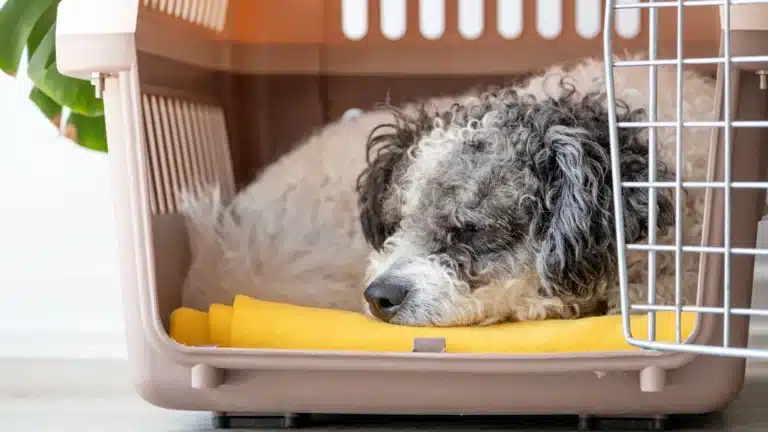Crate Training a Puppy or Adult Dog
One main reason for crate training is its role in house training. Dogs usually avoid soiling in their sleeping area, so crate training can teach them bladder control and help establish a consistent potty routine. Additionally, when left unsupervised, dogs may become destructive. A crate provides a controlled space that keeps them safe and out of trouble when you cannot supervise them.
Crate training also significantly eases travel and vet visits. Dogs that are used to their crates feel less stressed during transportation, whether in a car or at a veterinary clinic. Crate training can help with separation anxiety, allowing dogs to feel comfortable alone and reducing excessive barking when their owners are absent.

Why Crate Training is Important
One of the primary advantages of crate training is its role in house training. Dogs naturally avoid soiling their sleeping area, so crating can encourage bladder control and help establish a consistent potty routine. Additionally, when left unsupervised, dogs may engage in destructive behaviours, such as chewing on furniture or household items. A crate provides a controlled space that keeps them safe and out of trouble when you cannot supervise them.
Crate training also significantly eases travel and vet visits. Dogs accustomed to their crates feel less stressed during transportation, whether in a car or at a veterinary clinic, as they associate the crate with safety and familiarity. Furthermore, crate training can help combat separation anxiety, allowing dogs to feel comfortable alone and reducing excessive barking when their owners are absent.
Choosing the Right Crate
- The perfect crate should be comfortable, well-ventilated, and the right size for your dog.
The crate should be big enough for your dog to stand, turn around, and lie down in it. However, it shouldn’t be so large that your dog can use it as a bathroom. If you have a puppy, choose a crate with a divider to expand the space as they grow. Here’s what to consider:
Types of Crates
- Wire Crates
- Provides excellent ventilation
- Foldable and easy to store
- Some come with dividers for growing puppies
- Suitable for most breeds
- Plastic Crates
- More enclosed, creating a cozy den-like feel
- Ideal for travel (especially airline-approved crates)
Suitable for dogs that prefer a darker, enclosed space
- Soft-Sided Crates
- Lightweight and portable
- Great for small dogs and travel
- Not ideal for heavy chewers
- Furniture-Style Crates
- Stylish designs that blend with home décor
- It can double as an end table or bench
- Best for well-behaved dogs
- Size of Crates
- Extra Small (1-10 lbs): Chihuahua, Yorkie 18-22 inches Crate
- Small (11-25 lbs): Pug, Miniature Schnauzer 24 inches Crate
- Medium (26-50 lbs): Cocker Spaniel, Border Collie 30 inches Crate
- Large (51-75 lbs): Labrador Retriever, Boxer 36-42 inches Crate
- Extra Large (76+ lbs): Great Dane, Saint Bernard 48+ inches Crate
Step-by-Step Guide to Crate Training
Crate training should be a positive experience. Follow these steps to introduce the crate properly and make your dog feel comfortable inside.
Step 1: Introduce the Crate
- Take it slow.
- Place the crate in a common area where your dog spends time.
- Keep the door open and let them explore freely.
- Never force your dog inside, and let them check it out on their own.
- Use a crate cover if your dog prefers a darker, enclosed space.
Step 2: Associate the Crate with Positive Things
- Once your dog is comfortable near the crate, start linking it to good experiences.
- Feed meals inside the crate. Start by placing a food bowl near the entrance, then gradually move it further inside.
- Toss treats inside and let your dog retrieve them.
- Give your pup a special toy they only get when in the crate.
- Patience is key. This stage might take a few days or a couple of weeks.
Step 3: Encourage Short Stays
Once your dog is comfortable going inside, close the door for a few seconds, then let them out.
Start by closing the door for a few seconds while they eat.
Gradually increase the time, giving lots of praise and treats.
If they whine, don’t rush to let them out. Wait until they’re calm so they don’t learn that whining opens the door.
Gradually increase the time they stay inside with the door closed.
Step 4: Extend the Time
Once your pup is comfortable with short stays, increase the duration.
Encourage rest time in the crate by adding a chew toy or a Kong with peanut butter.
Sit nearby at first, then start leaving the room for short periods.
Keep greetings and departures calm to prevent anxiety.
Step 5: Leaving the House
Once your dog can comfortably stay inside for 30 minutes, you can start leaving them in the crate while you go out.
Keep departures and arrivals low-key to prevent anxiety.
Step 6: Overnight Crating
Most dogs can sleep in their crates at night within a week or two.
Take them out for a potty break before bed.
Keep the crate in your bedroom at first so they feel reassured.
If your puppy cries, take them outside for a quick potty break, but keep it all business, no playtime or cuddles.
Crate Training Schedule for Puppies
8-10 weeks 30-60 minutes
11-14 weeks 1-3 hours
15-16 weeks 3-4 hours
17+ weeks 4-6 hours
Puppies can’t hold their bladder for long! Always take them out for potty breaks frequently.
Crate Training Do's and Don'ts
Do: Make the crate a positive space with treats and toys.
Do: Start with short sessions and gradually increase time.
Do: Take your dog outside for potty breaks before crating.
Do: Use the crate for nap times and bedtime.
Don’t: Use the crate as punishment—it should be a happy place!
Don’t: Leave your dog crated for too long.
Don’t: Ignore whining—puppies may need to go potty!
Don’t: Let your dog out when it is barking or whining (unless it needs to go outside).
Common Crate Training Challenges
Whining and Crying
- It’s normal for dogs to whine when first getting used to a crate.
- But how do you know if they need to go potty or just want attention?
- If it’s been a while since their last potty break, take them outside calmly and bring them back to the crate.
- If they whine immediately after being put in, ignore them unless they sound distressed.
- Never let them out mid-whine, wait for a moment of quiet before opening the crate.
- Covering a wire crate with a blanket can create a den-like feeling and reduce anxiety.
Refusing to Enter the Crate
- If your dog avoids the crate, make it more appealing.
- Never force them in and use treats, toys, and meals instead.
- Keep the door open and let them explore at their own pace.
- Play games like tossing treats inside and letting them retrieve them.
Accidents in the Crate
- Take your dog out more frequently.
- Ensure the crate isn’t too big.
- Stick to a bathroom schedule. Puppies need frequent potty breaks.
- Clean thoroughly with a cleaner that removes odours and prevents repeat accidents.
Chewing or Trying to Escape
- Provide appropriate chew toys.
- Avoid using the crate as punishment.
When and How to Stop Using the Crate
Crates are useful, but they aren’t forever. Once your dog is fully house-trained and no longer destructive, you can transition them to more freedom.
- Start with short unsupervised periods. Leave them in a dog-proofed area.
- Gradually increase their space. Open up one room at a time.
- Keep the crate available. Many dogs still love their crates as a cozy retreat.
Frequently Asked Questions
- Is putting a dog in a crate cruel?
Not at all! When used properly, a crate provides security and helps with training. Just ensure your dog isn’t crated for excessive periods. - Should I put water in the crate?
It’s best not to leave water in the crate overnight for puppies, as they might have accidents. A small, spill-proof water bowl can be provided for adult dogs for extended stays. - What if my dog hates the crate?
Some dogs take longer to adjust. Keep the door open, make it comfy, and use high-value treats to encourage them. Never force them inside. - Can I crate-train an older dog?
Absolutely! Older dogs may take longer to adapt, but they can learn to love their crate with patience and positive reinforcement. - Should I let my puppy sleep in the crate at night?
Yes! This helps with potty training and teaches them to settle. Keep the crate near your bed for reassurance during the first few nights. - When should I stop using a crate?
Once your dog is fully house-trained and comfortable being alone without destructive behaviour, you can gradually transition them to more freedom.
Crate training is a great way to create a well-behaved and confident dog. Patience, kindness, and consistency can improve your dog’s habits, whether you are house-training a puppy or giving structure to an adult dog. Let your dog learn at its own pace and keep the training experience positive and rewarding. Over time, your dog will see its crate as a safe and comfortable place, similar to its favourite toy.
